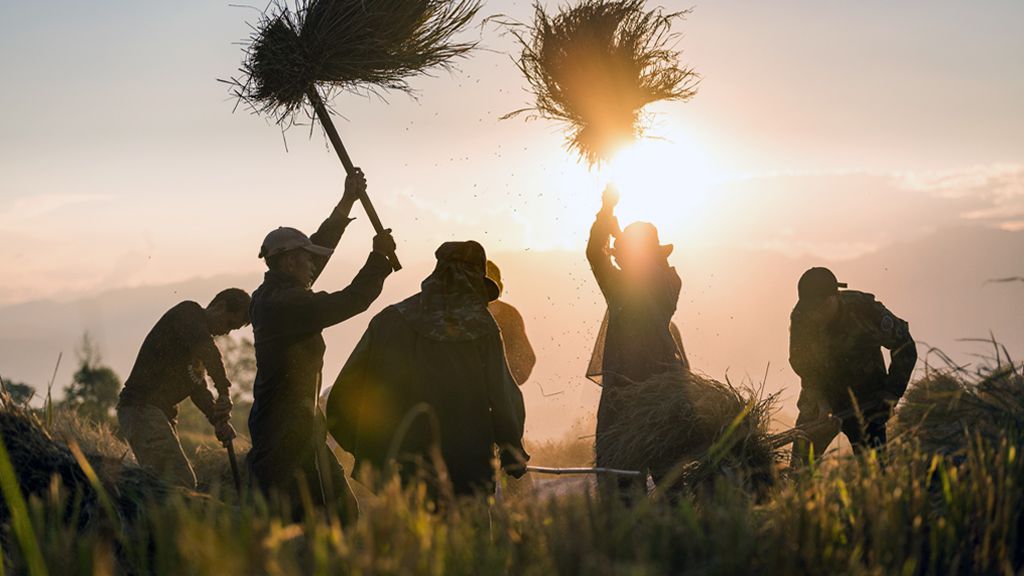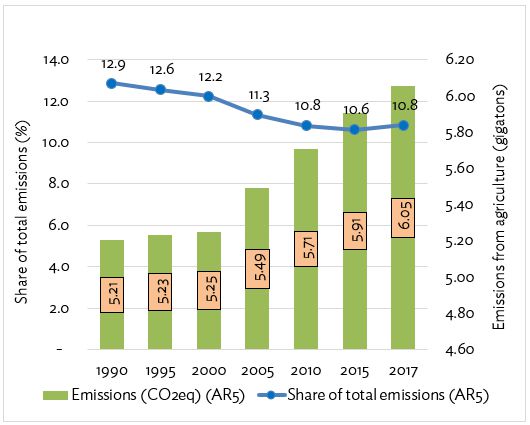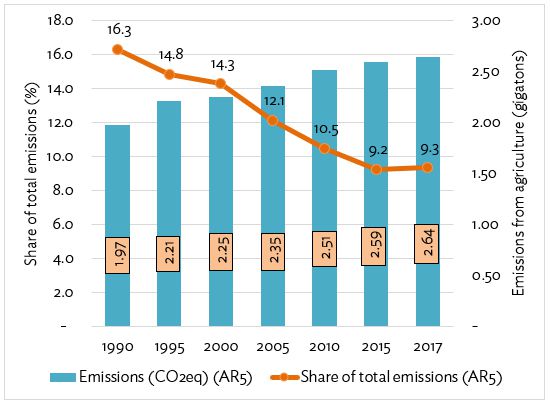
The connection between climate change and agriculture (both crops and livestock) is complex. On the one hand, agriculture is adversely affected by climate change (Aryal et al. 2020a; Lobell et al. 2011), but on the other hand, it is also one of the major factors exacerbating climate change (Smith et al. 2008; Aryal et al. 2020b). Climate-smart agriculture (CSA) could play a crucial role in reducing GHG emissions and mitigating the adverse effects of climate change.
Impact of climate change on agriculture
Agriculture is extremely vulnerable to climate change due to its heavy reliance on precipitation and natural temperatures. Long-term changes in climate patterns can shift cropping seasons, affect the suitability of crop cultivation zones, and also increase the incidence of crop and livestock diseases and crop pests, jeopardizing yields, the storage of harvests, and, overall, the value chains of food markets. In India, global warming already reduced the wheat yield by almost 5% between 1981 and 2009 (Gupta et al. 2017). In Pakistan, between 1980 and 2014, spring maize growing periods shifted by about 5 days per decade, while the sowing of autumn maize was delayed by 3 days per decade, severely affecting yields (Abbas et al. 2017). Despite adaptive changes in crop management practices, negative effects of both season-long and terminal heat stress have been observed in the rice-wheat systems of South Asia (Arshad et al. 2017), which have ultimately affected the livelihoods of millions of farmers in the region, particularly those with a low adaptive capacity.
Climate change is highly likely to increase the occurrence and intensity of crop pests and diseases across the globe. With rising temperatures, crop pests and diseases are projected to expand to higher latitudes (Rosenzweig et al. 2001; Grünig et al. 2020). Global yield losses of three staple grains (i.e., rice, wheat, and maize) due to insect pests are expected to increase by 10%–25% per degree of global mean surface warming and will become more acute in temperate regions (Deutsch et al. 2018).
Agriculture and greenhouse gas emissions
Agriculture contributes significantly to total greenhouse gas (GHG) emissions in multiple ways, including through methane emissions from livestock and traditional paddy cultivation, nitrous oxide emissions from the use of nitrogen fertilizers, and carbon dioxide emissions from the burning of crops residues (Smith et al. 2014). Although the share of GHG emissions from agriculture in total anthropogenic GHG emissions has been declining, the absolute value of GHG emissions (CO2-equivalent) has been rising (FAOSTAT 2021). At the global level, the share of GHG emissions from agriculture declined from 12.9% in 1990 to about 10.8% in 2017, while total GHG emissions increased from 5.2 gigatons to 6.1 gigatons during the same period (Figure 1).
Figure 1: Emissions (CO2-equivalent) from Agriculture, Global

Source: FAOSTAT.
In Asia, the share of GHG emissions from agriculture declined from 16.3% in 1990 to 9.3% in 2017, although total GHG emissions from agriculture increased from 2.0 gigatons to 2.6 gigatons during the same period (Figure 2).
Figure 2: Emissions (CO2-equivalent) from Agriculture, Asia

Source: FAOSTAT.
Climate-smart agriculture: A way forward for addressing climate change
Considering the GHG emissions from agriculture and their sensitivity to climate change, climate-smart agriculture (CSA) can play an important role in reducing these emissions and improving resilience. For example, conservation agriculture-based wheat production, a CSA practice, helps crops adapt to climate extremes and enhances wheat yield (Aryal et al. 2016). Following this system in wheat farming also reduces GHG emissions compared to traditional wheat farming systems (Aryal et al. 2015).
There are several other CSA practices, such as laser land leveling, climate-smart livestock farming, site-specific nutrient management (SSNM), and the use of climate-stress tolerant varieties, that can contribute to reducing the climate challenges in agriculture. However, the benefits of CSA practices are yet to be realized on a full scale as many smallholder farmers, primarily in the Global South, face several constraints to adopting such practices. Limited knowledge of CSA practices, lacking or sparse rental markets for the machinery and equipment required for adopting these practices, and the low economic capacity of smallholders for investing in these practices are among the major constraints. As the large-scale adoption of CSA contributes to the global public good through the reduction of GHG emissions from agriculture and helps achieve the targets of the Paris Agreement and the Sustainable Development Goals, global coordination and cooperation for scaling up CSA is crucial for effective climate action in agriculture. One possible starting point is the dissemination of fertilizer management or SSNM in agriculture. Given that fertilizer markets and value chains are active across the globe, using this network for disseminating SSNM methods in agriculture can help reduce a significant amount of nitrous oxide emissions, which are a major source of anthropogenic GHG emissions as Aryal et al. (2021) and Sutton et al. (2013) attest. As smallholder farmers in developing countries have limited resilience capacity, the international society and national governments should consider using multiple networks for disseminating knowledge on SSNM, enhancing coordination between the public and private sectors to provide training to farmers on CSA, and investing in the scaling up CSA to address the climate change problem in agriculture.
_____
References:
Abbas, G., S. Ahmad, A. Ahmad, W. Nasim, Z. Fatima, S. Hussain, M. Habib ur Rehman, et al. 2017. Quantification the Impacts of Climate Change and Crop Management on Phenology of Maize-Based Cropping System in Punjab, Pakistan. Agricultural and Forest Meteorology 247: 42–55.
Arshad, M., T. S. Amjath-Babu, T. J. Krupnik, S. Aravindakshan, A. Abbas, H. Kächele, and K. Müller. 2017. Climate Variability and Yield Risk in South Asia’s Rice–Wheat Systems: Emerging Evidence from Pakistan. Paddy and Water Environment 15(2): 249–261.
Aryal, J. P., T. B. Sapkota, T. J. Krupnik, et al. 2021. Factors Affecting Farmers’ Use of Organic and Inorganic Fertilizers in South Asia. Environmental Science and Pollution Research.
Aryal, J. P., T. B. Sapkota, C. M. Stirling, M.L. Jat, H. S. Jat, M. Rai, S. Mittal, and J. M. Sutaliya. 2016. Conservation Agriculture-Based Wheat Production Better Copes with Extreme Climate Events than Conventional Tillage-Based Systems: A Case of Untimely Excess Rainfall in Haryana, India. Agriculture, Ecosystems & Environment 233: 325–335.
Aryal, J.P., T.B. Sapkota, M.L. Jat, and D.K. Bishnoi. 2015. On-Farm Economic and Environmental Impact of Zero-Tillage Wheat: A Case of North-West India. Experimental Agriculture 51(1): 1–16.
Aryal, J. P., D. B. Rahut, T. B. Sapkota, R. Khurana, and A. Khatri-Chhetri. 2020. Climate Change Mitigation Options among Farmers in South Asia. Environment, Development and Sustainability 22(4): 3267–3289.
Aryal, J. P., T. B. Sapkota, R. Khurana, A. Khatri-Chhetri, D. B. Rahut, and M. L. Jat. 2020. Climate Change and Agriculture in South Asia: Adaptation Options in Smallholder Production Systems. Environment, Development and Sustainability 22(6): 5045–5075.
Deutsch, C. A., J. J. Tewksbury, M. Tigchelaar, D. S. Battisti, S. C. Merrill, R. B. Huey, and R. L. Naylor. 2018. Increase in Crop Losses to Insect Pests in a Warming Climate. Science 361(6405): 916–919.
Grünig, M., D. Mazzi, P. Calanca, D. N. Karger, and L. Pellissier. 2020. Crop and Forest Pest Metawebs Shift towards Increased Linkage and Suitability Overlap under Climate Change. Communications Biology 3(1): 233.
Gupta, R., E. Somanathan, and S. Dey. 2017. Global Warming and Local Air Pollution Have Reduced Wheat Yields in India. Climatic Change 140(3): 593–604.
Lobell, D. B., W. Schlenker, and J. Costa-Roberts. 2011. Climate Trends and Global Crop Production Since 1980. Science 333(6042): 616–620.
Rosenzweig, C., A. Iglesias, X. B. Yang, P. R. Epstein, and E. Chivian. 2001. Climate Change and Extreme Weather Events; Implications for Food Production, Plant Diseases, and Pests. Global Change and Human Health 2(2): 90–104.
Smith, P., M. Bustamante, H. Ahammad, H. Clark, H. Dong, E. A. Elsiddig, H. Haberl, et al. 2014. Agriculture, Forestry and Other Land Use. In Climate Change 2014: Mitigation of Climate Change. Contribution of Working Group III to the Fifth Assessment Report of the Intergovernmental Panel on Climate Change, edited by O. Edenhofer, R. Pichs-Madruga, Y. Sokona, E. Farahani, S. Kadner, K. Seyboth, A. Adler, I. Baum, S. Brunner, P. Eickemeier, B. Kriemann, J. Savolainen, S. Schlomer, C. von Stechow, T. Zwickel, and J. C. Minx. Cambridge, United Kingdom, and New York, NY: Cambridge University Press, 811–922.
Smith, P., D. Martino, Z. Cai, D. Gwary, H. Janzen, P. Kumar, B. McCarl, et al. 2008. Greenhouse Gas Mitigation in Agriculture. Philosophical Transactions of the Royal Society of London. Series B, Biological Sciences 363(1492): 789–813.
Sutton M. A. et al. 2013. Our Nutrient World: The Challenge to Produce More Food and Energy with Less Pollution. Global Overview of Nutrient Management. Centre for Ecology and Hydrology, Edinburgh on Behalf of the Global Partnership on Nutrient Management and the International Nitrogen Initiative.









Comments are closed.